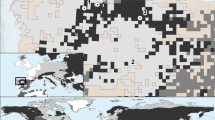Abstract
The longnose filefish,Oxymonacanthus longirostris, usually lives in heterosexual pairs, the male and female swimming together and sharing the same territory. Pair territoriality in the species was examined in detail in relation to sexual differences in territorial defense activities. Rigorous pair territoriality was maintained only during the breeding season, although pairs used their home ranges exclusively to a certain extent, during the non-breeding season. The frequency of aggression against other conspecific pairs in the breeding season was higher than in the non-breeding season. Agonistic interactions appear to be over both mates and food resources, the strict pair territoriality in the breeding season possibly being due to mutual mate guarding. In intraspecific aggressive interactions, males usually led their partner females when attacking intruders. The feeding frequency of males was much lower than that of females in the breeding season. Mate removal experiments indicated that females could not defend their original territories solitarily and their feeding frequency decreased. Conversely, males could defend territories solitarily without a decrease in feeding frequency. These results suggest that males contribute most to the defense of the pair territory, with females benefiting from territorial pair-swimming with their partner males.
Similar content being viewed by others
Literature Cited
Akagawa, I., Y. Tsukamoto and M. Okiyama. 1995. Sexual dimorphism and pair spawning into a sponge by the filefish,Brachaluteres ulvarum, with a description of the eggs and larvae. Japan. J. Ichthyol., 41:397–407.
Barlow, G. W. 1986. A comparison of monogamy among freshwater and coral-reef fishes. Pages 767–775in T. Ueno, R. Arai. T. Taniuchi and K. Matsuura, eds. Indo-Pacific fish biology: Proc. Sec. Int. Conf. Indo-Pacif. Fish. Icthyol. Soc. Japan, Tokyo.
Barlow, G. W. 1987. Spawning, eggs and larvae of the long-nose filefishOxymonacanthus longirostris, a monogamous corallivore. Env. Biol. Fish., 20:183–194.
Barlow, G. W. 1988. Monogamy in relation to resources. Pages 55–79in C. N. Slobodchikoff, ed. The ecology of social behavior. Academic Press, London.
Bagenal, T. B. 1966. The ecological and geographical aspects of the fecundity of plaice. J. Mar. Biol. Assoc. U. K., 46:743–751.
Brown, J. R. 1982. Optimal group size in territorial animals. J. Theor. Biol., 95:793–810.
Clifton, K. E. 1989. Territory sharing by the Caribbean striped parrotfish,Scarus iserti, patterns of resource abundance, group size and behaviour. Anim. Behav., 37:90–103.
Clifton, K. E. 1990. The costs and benefits of territory sharing for the Caribbean coral reef fish,Scarus iserti. Behav. Ecol. Sociobiol., 26:139–147.
Fricke, H. W. 1986. Pair swimming and mutual partner guarding in monogamous butterflyfish (Pisces, Chaetodontidae): a joint advertisement for territory. Ethology, 73:307–333.
Gore, M. A. 1983. The effect of a flexible spacing system on the social behaviour of a coral reef fish,Chaetodon capistratus. Behaviour, 85:118–145.
Hirshfield, M. F. 1980. An experimental analysis of reproductive effort and cost in the Japanese medaka,Oryzias latipes. Ecology, 61:282–292.
Hourigan, T. F. 1989. Environmental determinants of butterflyfish social systems. Env. Biol. Fish., 25:61–78.
Kawase, H. and A. Nakazono. 1994. Reproductive behavior of the honeycomb leatherjacket,Cantherhines pardalis (Monacanthidae), at Kashiwajima, Japan. Japan. J. Ichthyol., 41:80–83.
Kawase, H. and A. Nakazono. 1995. Predominant maternal egg care and promiscuous mating system in the Japanese filefish,Rudarius ercodes (Monacanthidae). Env. Biol. Fish., 43:241–254.
Kokita, T. and A. Nakazono. 1998. Plasticity in the mating system of the longnose filefish,Oxymonacanthus longirostris, in relation to mate availability. J. Ethol., 16:81–89.
Krebs, J. R. and N. B. Davies. 1993. An introduction to behavioural ecology. 3rd ed. Blackwell Scientific Publications, Oxford. 420 pp.
Matsuura, K. 1984. Tetraodontiforms. Pages 357–366, pls. 321–334in H. Masuda, K. Amaoka, C. Araga, T. Uyeno and T. Yoshino, eds. The fishes of the Japanese Archipelago, English text and plate. Tokai Univ. Press, Tokyo.
Reavis, R. H. and G. W. Barlow. 1998. Why is the coral-reef fishValenciennea strigata (Gobiidae) monogamous? Behav. Ecol. Sociobiol., 43:229–237.
Robertson, D. R., N. V. C. Polunin and K. Leighton. 1979. The behavioral ecology of three Indian Ocean surgeonfishes (Acanthurus lineatus, A. leucosternon & Zebrasoma scopas): their feeding strategies, and social and mating systems. Env. Biol. Fish., 4:125–170.
Sano, M., M. Shimizu and Y. Nose. 1984. Food habits of Telcostean reef fishes in Okinawa Islands, southern Japan. Univ. Mus. Univ. Tokyo, Bull. 25:1–128.
Tricas, T. C. 1989. Determinants of feeding territory size in the corallivorous butterflyfish,Chaetodon multicinctus. Anim. Behav., 37:830–841.
Yabuta, S. 1997. Why are so many butterflyfishes monogamous? Pages 65–91in T. Kuwamura and Y. Nakashima, eds. Reproductive strategies in fishes Vol. 2. KAIYUSHA Publishers, Tokyo. (In Japanese).
Author information
Authors and Affiliations
About this article
Cite this article
Kokita, T., Nakazono, A. Pair territoriality in the longnose filefish,oxymonacanthus longirostris . Ichthyological Research 46, 297–302 (1999). https://doi.org/10.1007/BF02678516
Received:
Revised:
Accepted:
Issue Date:
DOI: https://doi.org/10.1007/BF02678516




